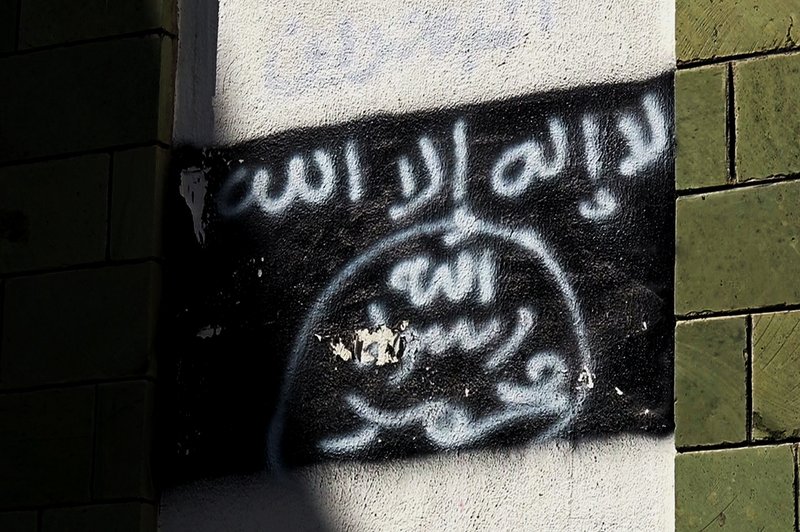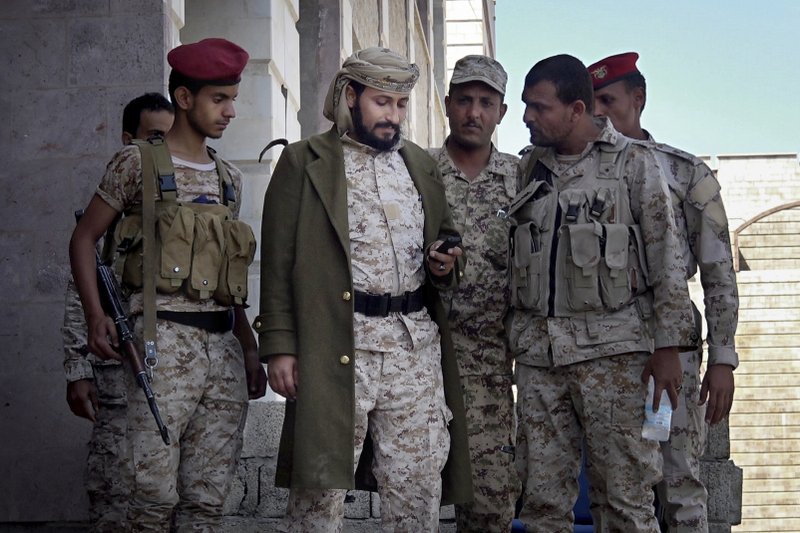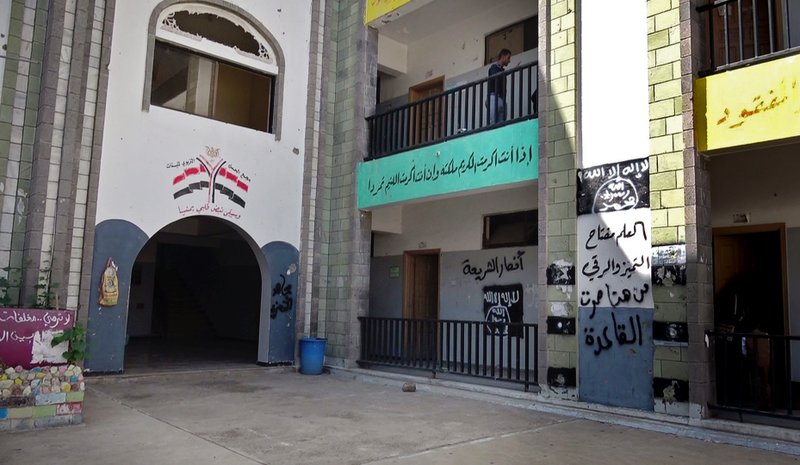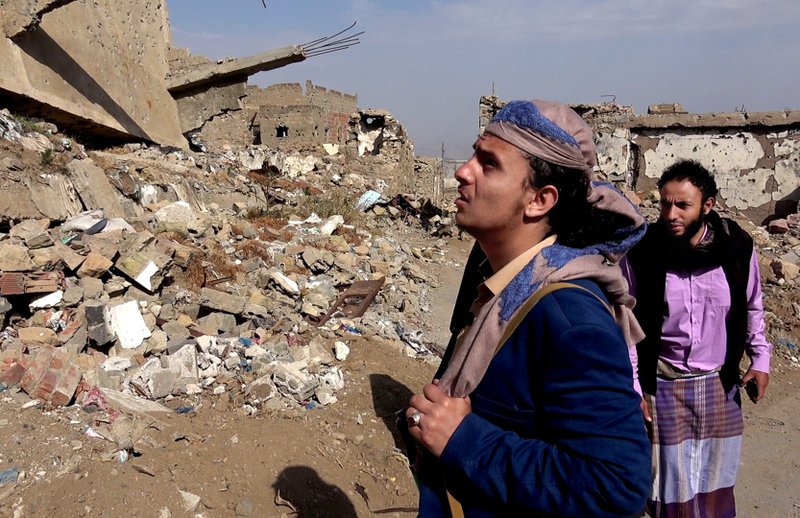AP investigation: Yemen war binds US, allies, al-Qaida
By MAGGIE MICHAEL, TRISH WILSON and LEE KEATH
ATAQ, Yemen (AP) — Again and again over the past two years, a military coalition led by Saudi Arabia and backed by the United States has claimed it won decisive victories that drove al-Qaida militants from their strongholds across Yemen and shattered their ability to attack the West.
Here’s what the victors did not disclose: many of their conquests came without firing a shot.
That’s because the coalition cut secret deals with al-Qaida fighters, paying some to leave key cities and towns and letting others retreat with weapons, equipment and wads of looted cash, an investigation by The Associated Press has found. Hundreds more were recruited to join the coalition itself.
These compromises and alliances have allowed al-Qaida militants to survive to fight another day — and risk strengthening the most dangerous branch of the terror network that carried out the 9/11 attacks. Key participants in the pacts said the U.S. was aware of the arrangements and held off on any drone strikes.

The deals uncovered by the AP reflect the contradictory interests of the two wars being waged simultaneously in this southwestern corner of the Arabian Peninsula.
In one conflict, the U.S. is working with its Arab allies — particularly the United Arab Emirates — with the aim of eliminating the branch of extremists known as al-Qaida in the Arabian Peninsula, or AQAP. But the larger mission is to win the civil war against the Houthis, Iranian-backed Shiite rebels. And in that fight, al-Qaida militants are effectively on the same side as the Saudi-led coalition — and, by extension, the United States.
The AP’s findings are based on reporting in Yemen and interviews with two dozen officials, including Yemeni security officers, militia commanders, tribal mediators and four members of al-Qaida’s branch.
Coalition-backed militias actively recruit al-Qaida militants, or those who were recently members, because they’re considered exceptional fighters, the AP found.

One Yemeni commander who was put on the U.S. terrorism list for al-Qaida ties last year continues to receive money from the UAE to run his militia, his own aide told the AP. Another commander, recently granted $12 million for his fighting force by Yemen’s president, has a known al-Qaida figure as his closest aide.
In one case, a tribal mediator who brokered a deal between the Emiratis and al-Qaida even gave the extremists a farewell dinner.
Horton said much of the war on al-Qaida by the UAE and its allied militias is a “farce.”
Al-Qaida is leveraging the chaos to its advantage.
Within this complicated conflict, al-Qaida says its numbers — which U.S. officials have estimated at 6,000 to 8,000 members — are rising.

The black al-Qaida flag and the slogan in Arabic “al-Qaida passed here,” on the right wall, are sprayed on a damaged school that was turned into a religious court in the southern city of Taiz.
“Meaning, if we send 20, we come back with 100,” he said.
A FAREWELL DINNER FOR AL-QAIDA
In February, Emirati troops and their Yemeni militia allies flashed victory signs to TV cameras as they declared the recapture of al-Said, a district of villages running through the mountainous province of Shabwa — an area al-Qaida had largely dominated for nearly three years.
It was painted as a crowning victory in a months-long offensive, Operation Swift Sword, that the Emirati ambassador to Washington, Yousef al-Otaiba, had proclaimed would “disrupt the terrorist organization’s network and degrade its ability to conduct future attacks.”
The Pentagon, which assisted with a small number of troops, echoed that promise, saying the mission would weaken the group’s ability to use Yemen as a base.
But weeks before those forces’ entry, a string of pickup trucks mounted with machine guns and loaded with masked al-Qaida militants drove out of al-Said unmolested, according to a tribal mediator involved in the deal for their withdrawal.
The U.S. has killed al-Qaida’s top leaders in a drone strike campaign that accelerated in recent years. But in this victory — as in the others touted by the coalition — the mediator said armed U.S. drones were absent, despite the large, obvious convoy.
Under the terms of the deal, the coalition promised al-Qaida members it would pay them to leave, according to Awad al-Dahboul, the province’s security chief. His account was confirmed by the mediator and two Yemeni government officials.
Al-Dahboul said about 200 al-Qaida members received payments. He did not learn the exact amounts, but said he knew that 100,000 Saudi rials ($26,000) were paid to one al-Qaida commander — in the presence of Emiratis.
Under the accord, thousands of local tribal fighters were to be enlisted in the UAE-funded Shabwa Elite Force militia. For every 1,000 fighters, 50 to 70 would be al-Qaida members, the mediator and two officials said.

A former al-Qaida commander, Harith al-Ezzi, walks through streets destroyed in fighting in the southern Yemeni city of Taiz. (AP Photo)
One former al-Qaida member told the AP that he and his comrades turned down an offer of money from the Emiratis. In response, he said, an Elite Force squad besieged them in the town of Hawta until they withdrew.
The militants were guaranteed a safe route out and allowed to keep weapons and cash looted from the city — up to $100 million by some estimates — according to five sources, including military, security and government officials.
“Coalition fighter jets and U.S. drones were idle,” said a senior tribal leader who saw the convoy leaving. “I was wondering why they didn’t strike them.”
A tribal sheikh shuttled between AQAP leaders in Mukalla and Emirati officials in Aden to seal the deal, according to a former senior Yemeni commander.
No witnesses reported militants killed, however. “We woke up one day and al-Qaida had vanished without a fight,” a local journalist said, speaking to AP on condition of anonymity for fear of reprisals.
Soon after, another accord was struck for AQAP to pull out of six towns in the province of Abyan, including its capital, Zinjibar, according to five tribal mediators involved in the negotiations.
Again, the central provision was that the coalition and U.S. drones cease all bombings as AQAP pulled out with its weapons, the mediators said.
The agreement also included a provision that 10,000 local tribesmen — including 250 al-Qaida militants — be incorporated into the Security Belt, the UAE-backed Yemeni force in the area, four Yemeni officials said.
For nearly a week in May 2016, the militants departed in trucks. One of the mediators told the AP that he threw the last of the departing fighters a farewell dinner among his olive and lemon orchards when they stopped at his farm to pay their respects.
Another mediator, Tarek al-Fadhli, a former jihadi once trained by al-Qaida leader Osama bin Laden, said he was in touch with officials at the U.S. Embassy and in the Saudi-led coalition, keeping them updated on the withdrawal.
“When the last one left, we called the coalition to say they are gone,” he said.
https://apnews.com/f38788a561d74ca78c77cb43612d50da
By MAGGIE MICHAEL, TRISH WILSON and LEE KEATH
ATAQ, Yemen (AP) — Again and again over the past two years, a military coalition led by Saudi Arabia and backed by the United States has claimed it won decisive victories that drove al-Qaida militants from their strongholds across Yemen and shattered their ability to attack the West.
Here’s what the victors did not disclose: many of their conquests came without firing a shot.
That’s because the coalition cut secret deals with al-Qaida fighters, paying some to leave key cities and towns and letting others retreat with weapons, equipment and wads of looted cash, an investigation by The Associated Press has found. Hundreds more were recruited to join the coalition itself.
These compromises and alliances have allowed al-Qaida militants to survive to fight another day — and risk strengthening the most dangerous branch of the terror network that carried out the 9/11 attacks. Key participants in the pacts said the U.S. was aware of the arrangements and held off on any drone strikes.

The deals uncovered by the AP reflect the contradictory interests of the two wars being waged simultaneously in this southwestern corner of the Arabian Peninsula.
In one conflict, the U.S. is working with its Arab allies — particularly the United Arab Emirates — with the aim of eliminating the branch of extremists known as al-Qaida in the Arabian Peninsula, or AQAP. But the larger mission is to win the civil war against the Houthis, Iranian-backed Shiite rebels. And in that fight, al-Qaida militants are effectively on the same side as the Saudi-led coalition — and, by extension, the United States.
The AP’s findings are based on reporting in Yemen and interviews with two dozen officials, including Yemeni security officers, militia commanders, tribal mediators and four members of al-Qaida’s branch.
Coalition-backed militias actively recruit al-Qaida militants, or those who were recently members, because they’re considered exceptional fighters, the AP found.

One Yemeni commander who was put on the U.S. terrorism list for al-Qaida ties last year continues to receive money from the UAE to run his militia, his own aide told the AP. Another commander, recently granted $12 million for his fighting force by Yemen’s president, has a known al-Qaida figure as his closest aide.
In one case, a tribal mediator who brokered a deal between the Emiratis and al-Qaida even gave the extremists a farewell dinner.
Horton said much of the war on al-Qaida by the UAE and its allied militias is a “farce.”
Al-Qaida is leveraging the chaos to its advantage.
Within this complicated conflict, al-Qaida says its numbers — which U.S. officials have estimated at 6,000 to 8,000 members — are rising.

The black al-Qaida flag and the slogan in Arabic “al-Qaida passed here,” on the right wall, are sprayed on a damaged school that was turned into a religious court in the southern city of Taiz.
“Meaning, if we send 20, we come back with 100,” he said.
A FAREWELL DINNER FOR AL-QAIDA
In February, Emirati troops and their Yemeni militia allies flashed victory signs to TV cameras as they declared the recapture of al-Said, a district of villages running through the mountainous province of Shabwa — an area al-Qaida had largely dominated for nearly three years.
It was painted as a crowning victory in a months-long offensive, Operation Swift Sword, that the Emirati ambassador to Washington, Yousef al-Otaiba, had proclaimed would “disrupt the terrorist organization’s network and degrade its ability to conduct future attacks.”
The Pentagon, which assisted with a small number of troops, echoed that promise, saying the mission would weaken the group’s ability to use Yemen as a base.
But weeks before those forces’ entry, a string of pickup trucks mounted with machine guns and loaded with masked al-Qaida militants drove out of al-Said unmolested, according to a tribal mediator involved in the deal for their withdrawal.
The U.S. has killed al-Qaida’s top leaders in a drone strike campaign that accelerated in recent years. But in this victory — as in the others touted by the coalition — the mediator said armed U.S. drones were absent, despite the large, obvious convoy.
Under the terms of the deal, the coalition promised al-Qaida members it would pay them to leave, according to Awad al-Dahboul, the province’s security chief. His account was confirmed by the mediator and two Yemeni government officials.
Al-Dahboul said about 200 al-Qaida members received payments. He did not learn the exact amounts, but said he knew that 100,000 Saudi rials ($26,000) were paid to one al-Qaida commander — in the presence of Emiratis.
Under the accord, thousands of local tribal fighters were to be enlisted in the UAE-funded Shabwa Elite Force militia. For every 1,000 fighters, 50 to 70 would be al-Qaida members, the mediator and two officials said.

A former al-Qaida commander, Harith al-Ezzi, walks through streets destroyed in fighting in the southern Yemeni city of Taiz. (AP Photo)
One former al-Qaida member told the AP that he and his comrades turned down an offer of money from the Emiratis. In response, he said, an Elite Force squad besieged them in the town of Hawta until they withdrew.
The militants were guaranteed a safe route out and allowed to keep weapons and cash looted from the city — up to $100 million by some estimates — according to five sources, including military, security and government officials.
“Coalition fighter jets and U.S. drones were idle,” said a senior tribal leader who saw the convoy leaving. “I was wondering why they didn’t strike them.”
A tribal sheikh shuttled between AQAP leaders in Mukalla and Emirati officials in Aden to seal the deal, according to a former senior Yemeni commander.
No witnesses reported militants killed, however. “We woke up one day and al-Qaida had vanished without a fight,” a local journalist said, speaking to AP on condition of anonymity for fear of reprisals.
Soon after, another accord was struck for AQAP to pull out of six towns in the province of Abyan, including its capital, Zinjibar, according to five tribal mediators involved in the negotiations.
Again, the central provision was that the coalition and U.S. drones cease all bombings as AQAP pulled out with its weapons, the mediators said.
The agreement also included a provision that 10,000 local tribesmen — including 250 al-Qaida militants — be incorporated into the Security Belt, the UAE-backed Yemeni force in the area, four Yemeni officials said.
For nearly a week in May 2016, the militants departed in trucks. One of the mediators told the AP that he threw the last of the departing fighters a farewell dinner among his olive and lemon orchards when they stopped at his farm to pay their respects.
Another mediator, Tarek al-Fadhli, a former jihadi once trained by al-Qaida leader Osama bin Laden, said he was in touch with officials at the U.S. Embassy and in the Saudi-led coalition, keeping them updated on the withdrawal.
“When the last one left, we called the coalition to say they are gone,” he said.
https://apnews.com/f38788a561d74ca78c77cb43612d50da
